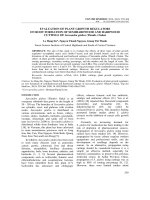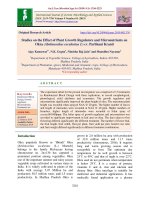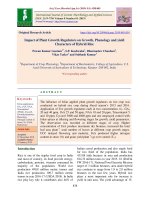Effect of plant growth regulators and chemicals on seed germination, vigour index and mortality of avocado (Persea americana Mill.)
Bạn đang xem bản rút gọn của tài liệu. Xem và tải ngay bản đầy đủ của tài liệu tại đây (180.26 KB, 6 trang )
Int.J.Curr.Microbiol.App.Sci (2020) 9(8): 3640-3645
International Journal of Current Microbiology and Applied Sciences
ISSN: 2319-7706 Volume 9 Number 8 (2020)
Journal homepage:
Original Research Article
/>
Effect of Plant Growth Regulators and Chemicals on Seed Germination,
Vigour Index and Mortality of Avocado (Persea americana Mill.)
Nangialai Hakimi*, B. S. Shivakumar, D. Lakshmana,
M. Ganapathi and Nagarappja Adivappar
Department of fruit science, University of Agricultural and Horticultural sciences,
Shivamogga, College of Horticulture, Mudigere-577-132, India
*Corresponding author
ABSTRACT
Keywords
Avocado, Seed
germination,
GA3, Ethrel,
KNO3, Thiourea
Article Info
Accepted:
26 July 2020
Available Online:
10 August 2020
Study on effect of plant growth regulators and chemicals on seed germination of
avocado (Persea americana Mill.) was carried out in college of Horticulture,
Mudigere, during the year 2019-2020, under Complete Randomized Design with
thirteen treatments and replicated thrice. Seeds were soaked in different solutions
of plant growth regulators and chemicals. Among all treatments seeds soaked in
GA3 400 ppm recorded early germination (13.00 days), 50 per cent germination
(19.33 days), highest germination percentage (95.22), maximum shoot length
(75.67 cm) and seedling vigour index-I and II (9878.54 and 806.60, respectively).
Among all the treatments, GA3 400 ppm was superior to the other treatments,
followed by GA3 600 ppm for the enhancement of germination traits.
Introduction
Avocado (Persea americana Mill.) belong to
family Lauraceae and it is native to the
Central America and Southern Mexico,
presently one of the most sought after food
sources worldwide. Avocado is also called as
Butter fruit for its buttery taste of pulp and
gained importance over year as one of the
most nutritive fruit. This fruit is also known
by the name ‘Alligator Pear’ and ‘fruit of new
world (Radha and Mathew 2007). Butter fruit
is rich in fat (26.4 g) and flesh of some
varieties has twice the energy value of
bananas. Fat is low in sugar content and easily
digestible, hence it is a recommended fruit for
diabetic patients. It contains one to two times
more protein (1.70 g) than any other fruit, is
rich in minerals such as manganese (35.00
mg), phosphorous (38.00 mg), iron (0.60 mg)
and potassium (368.00 mg) but low in sodium
(3.00 mg). Also contains the vitamins niacin
(1.01 mg) vitamin E, vitamin C, ß-carotene
(0.17 g), thiamine (0.06 mg), riboflavin (0.13
mg), nicotinic acid, folate, total carbohydrates
(5.10 g) and energy value of 245.00 calories
(Rainey et al., 1994).The commercial
avocado production is based on grafting of
3640
Int.J.Curr.Microbiol.App.Sci (2020) 9(8): 3640-3645
cultivars onto rootstocks mainly on the
Mexican and Guatemalan races. In
subtropical
climates,
the
Guatemalan
genotypes
represent
the
dominant
horticultural race. Avocado was brought to
India during the first decade of the nineteenth
century by an American missionary, residing
in Bangalore between the years 1906 and
1914. In India it is growing in tropical and
subtropical regions like Tamil Nadu, Sikkim,
Kerala, Maharashtra and Karnataka. In India,
avocado is generally propagated through
seeds. The viability of seeds of avocado is
quite short (2 to 3 weeks) but this can be
improved by storage the seed in dry peat or
sand at 50°C. Removal of seed coat before
sowing, use of plant growth regulators and
chemicals improves seed germination. In
India, most of the trees grown are seedlings in
origin. The seeds taken from ripe fruits are
sown directly in the nursery or in
polyethylene bags, then 8-12 months old, the
seedlings are ready for transplanting. The
seedling trees have long juvenile phase, yield
and fruit quality is highly variable due to
heterozygous nature, it is impossible to obtain
genetically uniform plant as needed for the
formation of commercial orchards. Avocado
is vegetatively propagating through various
methods like softwood stem cuttings taken
from young avocado seedlings, hardwood and
semi-hardwood cuttings, layering, grafting
and budding and there is a great demand for
production of rootstock (Tripathi and
Kuranakaran, 2013). Hence, the current study
was undertaken to find out the effect of plant
growth regulators and chemicals on seed
germination of avocado.
Materials and Methods
The experiment was carried out at College of
Horticulture, Mudigere during the year 20192020. It was laid out in Complete
Randomized
Design
(CRD)
thirteen
treatments with three repetitions viz. water
soaking as control (T1), GA3 200 ppm (T2),
GA3 400 ppm (T3), GA3 600 ppm (T4), ethrel
10 ppm (T5),ethrel 20 ppm (T6), ethrel 30
ppm (T7), KNO3 1.0 per cent (T8), KNO3 1.5
per cent (T9), KNO3 2.0 per cent (T10),
thiourea 1.0 per cent (T11), thiourea 1.5 per
cent (T12) and thiourea 2.0 per cent. (T13). For
experiment purpose fresh and disease free
seeds of avocado are collected and extracted
and seeds soaked in different concentrations
of GA3, ethrel, KNO3 and thiourea for 8 hours
and seeds sown in polybags under the polytunnel. Polybags having a length of 15 cm and
diameter of 10 cm with 200 gauge thickness
were used and filled with soil + sand + FYM
in the ratio of 1:1:1, respectively. Treated
seeds of avocado were sown in polybags of
20 X 10 cm size filled in different mixture
and its combinations on 28/09/2020. One seed
per poly bag was sown at 5-10 mm depth.
Watering was done regularly to maintain the
uniform moisture. Necessary plant protection
measures were taken. Five representative
plants from each treatment were selected and
observed
for
different
germination
parameters,
growth
characters
and
biochemical parameter. The experimental data
recorded on various parameters during the
investigation were analyzed statistically using
the method of analysis of variance (ANOVA)
for Complete Randomized Design (CRD) by
Fisher and Yates (1963). Whenever ‘F’ test
was found significant for comparing the
means of two treatments, the critical
difference (C.D. at 5%) was worked out.
Results and Discussion
The data presented in Table 1 clearly shows
that plant growth regulators and chemicals
had significant influence on germination
characters of avocado. Among the different
treatments the earliest germination (13.00
days) was recorded significantly when seeds
treated with GA3 400 (T3) and maximum days
taken for initiation of germination (20.67
3641
Int.J.Curr.Microbiol.App.Sci (2020) 9(8): 3640-3645
days) was recorded in control (T1). The
increase in germination due to involvement of
gibberellic acid in the activation of
cytological enzymes along with increase in
cell wall plasticity and better water
absorption.
Table.1 Effect plant growth regulators and chemicals on seed germination of avocado
Tr.
No.
Treatments
T1
T2
T3
T4
T5
T6
T7
T8
T9
T10
T11
T12
T13
Water soaking (control)
GA3 @ 200 ppm
GA3 @ 400 ppm
GA3 @ 600 ppm
Ethrel @ 10 ppm
Ethrel @ 20 ppm
Ethrel @ 30 ppm
KNO3 @ 1.0%
KNO3 @ 1.5%
KNO3 @ 2.0%
Thiourea @ 1.0%
Thiourea @ 1.5%
Thiourea @ 2.0%
S. Em ±
C.D. @ 5%
Days taken for
initiation of
germination
20.67
15.33
13.00
13.33
15.33
15.00
14.33
15.33
16.67
17.67
15.67
17.00
19.33
0.77
2.24
Days taken for
50 per cent
germination
36.00
23.67
19.33
20.33
27.00
23.33
23.00
28.00
30.67
31.33
29.67
31.00
34.00
0.90
2.61
Germination
percentage
at 45 DAS
65.00
85.22
95.22
91.17
81.00
90.00
90.33
80.26
76.28
74.26
78.00
75.00
73.00
2.73
7.95
Shoot
length
(cm)
41.48
58.20
75.67
68.83
57.89
58.70
63.43
56.18
53.98
45.81
55.42
52.76
43.81
3.75
10.90
Mortality
percentage
at 90 DAS
28.57
7.14
2.38
4.76
11.90
9.52
4.76
14.28
19.04
14.25
16.66
23.80
26.19
1.30
3.79
Table.2 Effect of plant growth regulators and chemicals on seedling vigour index I and II of
avocado at 90 days after sowing
Tr. No.
T1
T2
T3
T4
T5
T6
T7
T8
T9
T10
T11
T12
T13
Treatments
Water soaking (control)
GA3 @ 200 ppm
GA3 @ 400 ppm
GA3 @ 600 ppm
Ethrel @ 10 ppm
Ethrel @ 20 ppm
Ethrel @ 30 ppm
KNO3 @ 1.0%
KNO3 @ 1.5%
KNO3 @ 2.0%
Thiourea @ 1.0%
Thiourea @ 1.5%
Thiourea @ 2.0%
S. Em ±
C.D. @ 5%
Seedling index-I
3802.50
6834.64
9878.54
8677.36
6394.77
7276.00
7970.11
6182.69
5569.29
4698.18
5941.87
5325.00
4470.03
331.74
964.36
3642
Seedling index-II
229.38
459.61
806.60
569.25
429.91
504.83
522.54
405.58
340.52
310.59
367.72
317.34
282.60
28.85
83.87
Int.J.Curr.Microbiol.App.Sci (2020) 9(8): 3640-3645
It may be due to the fact that, GA3impacts on
initial enzyme stimulation and activation of
reserve food mobilization intern improves
germination. These findings are supported by
Gupta (1989) in citrus, Ratan and Reddy
(2004) in custard apple, Babu et al., (2010) in
papaya and Satya et al., (2018) in jamun.
The minimum days to 50 per cent germination
(19.33 days) was observed significantly with
GA3 400 ppm (T3) while, the maximum days
taken to 50 per cent germination was
observed in control (T1). GA3 helps in
synthesis of α- amylase which converts the
starch into simple sugars. These sugars
provide energy that is required for various
metabolic and physiological activities. Similar
result was reported by Meena et al., (2003) in
papaya. The findings of Venkatrao and Reddy
(2005) in mango and Kumar et al., (2008) in
mango, Satya et al., (2018) in jamun are close
to the conformity of the findings.
The maximum germination percentage (95.22
%) was noted significantly when seed soaked
in GA3 400 ppm (T3) whereas, the minimum
germination percentage (65 %) was noted in
control (T1). The promotive effect of GA3 on
seed germination might be due to enzyme άamylase is activated which converts starch
into simple carbohydrate and chemical energy
is released which intern activates embryo.
Also might be due to, the production of amino
acids in plants is enhanced, which is
indirectly exhibited by improved growth of
whole plant. The current findings is supported
by Reddy and Khan (2001) in khirni, Jadhav
(2003) in Rangpur lime, Sulabha and
Kherdekar (2003) in Kagzi lime, Singh et al.,
(2011) in manila tamarind and Satya et al.,
(2018) in jamun.
The data in Table 1 shows that ethrel at
concentrations of 20 and 30 ppm i.e. T6 and
T7 (90.00 and 90.33 %, respectively) also had
significant effect on germination percentage
of avocado after 45 days of sowing. Increased
germination per cent with ethrel for 8 hours
soaking period might be due to fact that ethrel
being ethylene releasing compound, the
localized production of ethylene is
responsible for the initiation, formation and
maintenance of either the plume arch,
hypocotyl hook, depends on mode of
germination. Ethylene is insoluble in water
but soluble in lipids, therefore.it associated
with lipid fraction of cell membrane and
affects membrane structure permeability.
Significantly, the highest shoot length (75.67
cm) of avocado seedlings was observed when
seeds soaked in GA3 400 ppm (T3) which was
statistically on par with T4 i.e. GA3 600 ppm.
Whereas, the lowest shoot length (41.48 cm)
was noted in control (T1). This variation
might be due to additional GA3, activated άamylase which digested the available
carbohydrate into simple sugar so that energy
and nutrition were easily available to faster
growing seedlings. The increase in plant
height due to GA3 has also been reported by
Babu et al., (2010) in papaya. The similar,
results was reported by Wanyama et al.,
(2006) in Cape gooseberry, Kumar et al.,
(2008) in mango, Mishra et al., (2017) in
papaya and Satya et al., (2018) in jamun.
The data presented in Table 1 clearly
indicates that growth regulators and chemicals
had significant influence of mortality
percentage of avocado seedlings at 90 days
after sowing. Among the different treatments
the least mortality percentage of seedling
(2.38 %) was recorded significantly with GA3
400 ppm (T3), which was statistically on par
with (T4 and T7) and maximum mortality of
seedling (28.57 %) was noted in control (T1).
This could be attributed to softening of seed
for exchange of gaseous and moisture and
availability of food material required for early
and better germination in this treatment. Early
germination might have resulted in faster and
3643
Int.J.Curr.Microbiol.App.Sci (2020) 9(8): 3640-3645
stronger root development, which might have
supported for better development of stem and
leaves in these seedlings, that might have
resulted in increased in survival of seedlings.
This might be also due to availability of
favorable amount of light, temperature and
humidity under poly-house or shade net
condition, which makes the plants harder and
able to withstand against adverse climatic
conditions. The result has been supported by
Ramteke et al., (2015) in papaya and
Chiranjeevi et al., (2017) in aonla.
A perusal of data presented in Table 2 shows
that plant growth regulators and chemicals
shown significant influence of seedling vigour
index I and II of avocado at 90 days after
sowing. The maximum SVI-I (9878.54) was
recorded significantly with GA3 400 ppm (T3)
and the minimum SVI-I (3802.50) was
recorded in control (T1). Enzymes as well as
physical and nutritional condition increased
the physiological activities of plant. These
finding are supported by Kumar et al., (2011)
in papaya, Padma et al., (2013)in papaya,
Gurung et al., (2014) in passion fruit and
Satya et al., (2018) in jamun.
The maximum SVI-II (806.60) was noted in
(T1) i.e. GA3 400 ppm while, the minimum
SVI-II was recorded in control (T1). The
maximum seedling vigour in GA3 treated
seeds is an account of increased rate of
metabolic
activities
like
respiration,
movement of photosynthates etc., (Earlplus
and Lambeth, 1974), which leads to increase
in root length, shoot size and seedling dry
weight, in turn increase in seedling vigour.
The results of Kumar et al., (2011) in papaya,
Padma et al., (2013) in papaya, Gurung et al.,
(2014) in passion fruit and Satya et al., (2018)
in jamun follow same trend.
In conclusion form the present investigation it
is concluded that GA3 400 ppm (T3) enhanced
the germination parameters, survival of
seedling and increased the seedling vigour
index of avocado followed by GA3 600 (T4).
References
Babu, K. D., Patel, R, K., Singh, A., Yadav,
D. S., De, L. C. and Deka, B. C., 2010.
Seed germination, seedling growth and
vigour of papaya under North East
Indian condition. Acta Hort.851: 299306.
Chiranjeevi, M. R., Muralidhara, B. M.,
Senha, M. K., Shivan and Hongal, 2017.
Effect of growth regulators and biofertilizers on germination and seedling
growth of Aonla. Int. J. Curr. Microbi.
App. Sci.6(12): 1320-1326.
Earlpus, E. J. R. and Lambeth, V. M.,1974.
Chemical stimulation of germination
rate in aged tomato seeds. J. Anzer. Sac.
Horti. Sci. 99(1): 912.
Fisher, R. A. and Yates, F., 1963. Statistical
tables for biological, medical and
agricultural research. Oliver and Boyd
Edinburgh. pp 86.
Gupta, O. P., 1989. Effect of gibberellic acid
on seed germination in lime (Citrus
aurantifolia Swingle.). Progressive
Hort. 21: 3-4, 246-248.
Gurung, N., Swamy, G. S. K., Sarkar, S. K.
andUbale, N. B., 2014. Effect of
chemicals and growth regulators on
germination, vigour and growth of
passion fruit (Passiflora edulis Sims.).
The Bioscan.9(1):155-157.
Jadhav, Y. S., 2003, Seed treatment studies in
Rangpure lime. M.Sc. (Agri.). Thesis
submitted to M.A.U, Parbhani.
Kumar, H. S., Swamy, Y., Kanmadi, G. S. K.,
Prasad, K. V. C. and Sowmaya, B. N.,
2008. Effect of organics and chemicals
on germination, growth and graft-take in
mango. Asian J. Hort. 3(2): 336-339.
Kumar, P., Sehrawat, S. K., Dahiya, O. S.
andDahiya, D. S., 2011. Papaya seed
priming in relation to seed vigour.
3644
Int.J.Curr.Microbiol.App.Sci (2020) 9(8): 3640-3645
Haryana J. Horti. Sci. 40(1&2):4-9.
Meena, R. R., Jain, M. C. and Mukherjee, S.,
2003. Effect of pre-sowing dip seed
treatment with gibberellic acid on
germination and survivability of Papaya.
Annals Plant and Soil Res. 5(1):120121.
Mishra, U., Bahadur, V., Prasad, V. M.,
Verty, P. S., Ashutosh, K., Mishra, S.
and Swaroop, N., 2017. Influence of
GA3 and growing media on growth and
seedling establishment of papaya
(Carica papaya L.) cv. PusaNanha. Int.
J. Curr. Microbiol. App. Sci. 6(11): 415422.
Padma, L., Basvaraju, G. V., Sarika, G.
andAmrutha, N., 2013. Effect of seed
treatment to enhance seed quality of
papaya (Carica papaya L.) cv. Surya.
GJBAHS. 2(3): 221- 225.
Radha, T. and Mathew, L., 2007. Fruit Crops
Book, Department of Fruit Science,
Kerala Agriculture University. Hort.
Sci. series.3: 130-130.
Rainey, C., Affleck, M., Bretschger, K. and
Roslyn, A. S., 1994. The California
avocado: A new look. Nutr. Today.
29:23-27.
Ramteke,
V.,
Paithanker,
D.
H.,
Kamatyanattii, M. and Baghel, M. M.,
2015. Studies on Seed germination and
seedling growth of papaya as Influenced
by GA3 and potting media, J.
progressive Agri. 6(1): 129-123.
Ratan, P. B and Reddy, Y. N., 2004. Influence
of gibberellic acid on custard apple
(Annona
squammosa
L.)
seed
germination and subsequent seedling
growth. J. Res. ANGRAU. 32(2): 93-95.
Reddy, Y. T. N. and Khan, M. M., 2001.
Effect of osmopriming on germination
seedlings
of
khirni
(Mimusops
hexandra) seeds. Seed Res. 29(1): 2447.
Satya, N. H., Ajay, K. K., Jain, P. K. and
Bharat, D., 2018. Effect gibberellic acid
on germination, growth and survival of
Jamun (Syzygium cumini L.). The
Pharma Innovation J. 7(8): 323-326.
Singh, R. S., Bhargava, R. and Pal, G., 2011.
Effect of seed treatments on germination
and growth behaviour in Manila
tamarind (Pithecello biumduice). J.
Tropical Forestry. 27(4): 6-10.
Sulabha Kherdekar., 2003. Effect of seed
treatment with plant growth regulators
and chemicals on germination of seed
and growth of seedling of Kagzi lime
(Citrus aurantifolia Swingle.). M.Sc.
(Agri.). Thesis submitted to M.K.V,
Parbhani.
Tripathi, P. C. and Karunakaran, G., 2013.
Bharat Mai Navaneet Phal (Avocado)
Ki
Kheti:
Varthamansthithievam
Sambhavanaye (InHindi) (Avocado
cultivation in India: Present status and
possibilities) Bhumi Nirman (Bhopal)
16th Jan -15th Feb: 11.
Venkatrao, andReddy, Y. T. N., 2005. Effect
of osmopriming on germination,
seedling growth and vigour of mango
(Mangifera indica L.) stones. Karnataka
J. Hort. 1(4): 29-35.
Wanyama, D. O., Wamocha, L. S. and
Ssnokko, R, N., 2006. Effect GA3 on
growth and fruit yield of greenhouse
grown Cape gooseberry. African J. Crop
Sci. 14(4): 319-323.
How to cite this article:
Nangialai Hakimi, B. S. Shivakumar, D. Lakshmana, M. Ganapathi and Nagarappja Adivappar.
2020. Effect of Plant Growth Regulators and Chemicals on Seed Germination, Vigour Index
and Mortality of Avocado (Persea americana Mill.). Int.J.Curr.Microbiol.App.Sci. 9(08):
3640-3645. doi: />3645
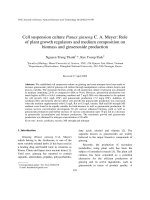



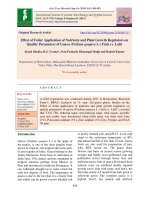
![Effect of different plant growth regulators on shooting of stem cuttings in dragon fruit [Hylocereus undatus (Haworth) Britton & Rose]](https://media.store123doc.com/images/document/2020_01/09/medium_isb1578564896.jpg)
